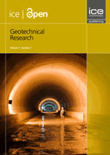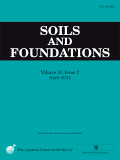
GEOTECHNIQUE
Scope & Guideline
Innovating Geotechnical Engineering for a Sustainable Future
Introduction
Aims and Scopes
- Soil and Rock Mechanics:
The journal covers fundamental and applied research in soil and rock mechanics, exploring their mechanical properties, behavior under various loading conditions, and implications for construction and stability. - Geotechnical Testing and Characterization:
Research on methodologies for testing and characterizing soils and rocks, including laboratory and field testing techniques, as well as advancements in measurement technologies. - Numerical and Analytical Modelling:
Development and application of numerical and analytical models to simulate geotechnical behavior, including finite element methods, discrete element modeling, and other computational techniques. - Environmental Geotechnics:
Focus on the interaction between geotechnical engineering and environmental issues, such as waste management, contaminant transport, and the effects of climate change on soil behavior. - Innovative Ground Improvement Techniques:
Research on new methods for improving ground conditions, including bioengineering approaches, chemical stabilization, and advanced materials.
Trending and Emerging
- Sustainable Geotechnics:
Research focused on sustainability in geotechnical engineering is on the rise, including studies on the use of recycled materials, bioengineering approaches, and environmentally friendly practices. - Advanced Computational Techniques:
There is a growing trend towards the use of advanced computational methods, such as machine learning and artificial intelligence, in modeling and predicting soil behavior. - Liquefaction and Ground Stability:
Research on liquefaction phenomena and ground stability under dynamic loading conditions is increasingly relevant, particularly in the context of natural disasters and infrastructure resilience. - Soil-Structure Interaction:
Studies exploring the complex interactions between soil and structures, especially in seismic contexts, are gaining prominence due to their importance in designing resilient infrastructure. - Smart Materials and Sensing Technologies:
The integration of smart materials and advanced sensing technologies in geotechnics is emerging, with research focusing on real-time monitoring and adaptive responses to changing conditions.
Declining or Waning
- Traditional Soil Mechanics:
Research focusing solely on classical soil mechanics principles appears to be waning, as more studies incorporate advanced materials and innovative methodologies. - Static Analysis Approaches:
There is a noticeable decline in publications centered on static analysis methods, as dynamic and time-dependent analyses gain more attention due to their relevance in contemporary engineering challenges. - Conventional Foundation Design:
Studies on conventional foundation design methods are becoming less common, with a shift towards more complex interactions and innovative foundation systems that address modern engineering needs. - Geotechnical Case Studies:
The frequency of traditional case studies documenting past projects is decreasing as the emphasis shifts to experimental and computational research that offers broader insights and applications.
Similar Journals

COMPUTERS AND GEOTECHNICS
Bridging the Gap between Computer Science and Geotechnical Engineering.COMPUTERS AND GEOTECHNICS is a premier scholarly journal published by Elsevier Science Ltd, devoted to advancing the intersection of computer science and geotechnical engineering. With an impressive impact factor and categorically recognized as a Q1 journal in both Computer Science Applications and Geotechnical Engineering as of 2023, it stands at the forefront of research in its field. The journal has maintained a remarkable reputation since its inception in 1985, providing a dynamic platform for disseminating cutting-edge research, technological advancements, and innovative methodologies related to the application of computer science in geotechnics. Researchers, professionals, and students benefit from its rigorous peer-review process and high-quality publications, which demonstrate practical applications and theoretical foundations necessary for the relevant industries. Renowned for an extensive global readership, COMPUTERS AND GEOTECHNICS plays a critical role in fostering collaboration and development in tackling complex geotechnical challenges through computational methods, all while contributing to the broader understanding of environmental interactions. This journal provides essential insights and is instrumental for those at the cutting edge of this evolving discipline.

Geotechnical Engineering
Connecting Researchers and Practitioners in Geotechnical EngineeringGeotechnical Engineering, published by the Southeast Asian Geotechnical Society, is a prominent journal dedicated to the field of geotechnical and civil engineering. With its ISSN of 0046-5828, this journal serves as a vital platform for researchers and practitioners to disseminate innovative findings and explore new methodologies within the discipline. Although currently listed in the Q4 quartile across both Civil and Structural Engineering and Geotechnical Engineering categories, Geotechnical Engineering is committed to fostering rigorous scholarship and community engagement in the dynamic field of geotechnical sciences. The journal covers a wide range of topics, providing an important resource for the engineering community. While it does not offer open access, it facilitates significant contributions that enhance the understanding and practice of geotechnical engineering in Southeast Asia and beyond, underscoring its vital role as a knowledge hub for researchers, professionals, and students alike.

Geotechnical Research
Pioneering research in geotechnical engineering excellence.Geotechnical Research is an esteemed scholarly journal published by EMERALD GROUP PUBLISHING LTD, dedicated to advancing the field of geotechnical engineering and earth sciences. With an impact factor reflective of its robust contributions, this open access journal has been providing unrestricted access to high-quality research since 2014, making it indispensable for researchers, professionals, and students alike. The journal, indexed under the ISSN 2052-6156, features rigorous peer-reviewed articles that encompass a wide range of topics within geotechnical engineering and engineering geology, achieving a notable placement in the Q2 category in both Earth and Planetary Sciences and Geotechnical Engineering as of 2023. With its Scopus ranks further affirming its significance—ranked #44 out of 159 in Earth and Planetary Sciences and #78 out of 229 in Geotechnical Engineering—Geotechnical Research stands as a vital resource for innovative solutions and advancements in this critical field, ensuring researchers access to essential insights that drive the discipline forward.

Rock and Soil Mechanics
Advancing Knowledge in Rock and Soil MechanicsRock and Soil Mechanics is a premier academic journal published by SCIENCE PRESS focusing on the critical fields of civil and structural engineering, geotechnical engineering, and soil science. With an ISSN of 1000-7598 and transitioning to an Open Access format since 2020, the journal strives to enhance the accessibility of cutting-edge research to a global audience, making significant contributions to practices and methodologies in these crucial disciplines. Ranked in the Q2 category for Civil and Structural Engineering as well as Geotechnical Engineering and Engineering Geology, and Soil Science, it boasts respectable standings in Scopus rankings, further affirming its relevance and credibility within the scientific community. The journal not only serves as a platform for original research but also engages with the latest advances in technology and innovative applications in rock and soil mechanics, proving invaluable for researchers, practitioners, and students alike as they navigate an increasingly complex field of study.

Soils and Rocks
Advancing Geotechnical Knowledge from the Ground UpSoils and Rocks is an academic journal dedicated to the field of Geotechnical Engineering and Engineering Geology, published by the Brazilian Association of Soil Mechanics and Geotechnical Engineering in collaboration with the Portuguese Geotechnical Society. Since becoming an Open Access platform in 2011, this journal has provided a vital publication outlet for researchers and professionals seeking to disseminate their findings on soil behavior, rock mechanics, and related topics within an international context. The journal is indexed in Scopus, holding a rank of 177 out of 229 in its category as of 2023, placing it in the 22nd percentile among its peers. Operating out of Brazil, Soils and Rocks encourages rigorous scholarly exchange and exploration of innovative practices within the sectors, making it an important resource for advancing knowledge in the geotechnical community. With a converged publication history from 2007 to 2024, the journal aims to foster significant advancements and insights that enhance our understanding of subsurface conditions and materials.

Geotechnical and Geological Engineering
Shaping the Landscape of Geotechnical KnowledgeGeotechnical and Geological Engineering, published by SPRINGER, is a premier journal dedicated to advancing the field of geotechnical and geological engineering. With a strong reputation demonstrated by a robust impact factor and notable Scopus rankings, the journal positions itself in the top quartile of categories such as Architecture and Geotechnical Engineering, making it an essential resource for researchers and practitioners alike. Established in 1991 and continuing through 2024, it provides a platform for original research that addresses the pivotal challenges in soil science, geology, and engineering geology. Although it does not offer open access, it remains accessible through institutional and personal subscriptions, ensuring that academic scholars, industry professionals, and students can engage with high-quality, peer-reviewed content. The journal's commitment to disseminating innovative findings and fostering interdisciplinary dialogue underscores its vital role in shaping future developments in engineering and environmental sustainability.

International Journal of Physical Modelling in Geotechnics
Unveiling the complexities of soil and rock interactions.The International Journal of Physical Modelling in Geotechnics, published by Emerald Group Publishing Ltd, is a leading platform dedicated to advancing the field of geotechnical engineering and engineering geology. With a focus on the practical applications of physical modeling, this journal contributes significantly to the understanding of soil and rock behavior under various conditions, making it invaluable for researchers, professionals, and students alike. Heightened by its Q2 ranking in its category and a notable 61st percentile ranking among its peers, this journal has established itself as a credible source of knowledge and innovation within the academic community. Although it does not currently offer open access, its rigorous peer-review standards ensure the dissemination of high-quality research and insights. The journal, covering a timeline of topics from 2011 to 2024, aims to bridge the gap between theory and practice, ultimately fostering advancements in geotechnical solutions necessary for infrastructure development. To stay at the forefront of geotechnical research, contributing authors and engaged readers are encouraged to explore and participate in this dynamic academic discussion.

Soil Mechanics and Foundation Engineering
Innovating Solutions in Geotechnical EngineeringSoil Mechanics and Foundation Engineering, published by SPRINGER, is a prestigious academic journal dedicated to the dynamic fields of soil mechanics and foundation engineering. With a history spanning from 1964 to 2024, this journal serves as a vital platform for researchers, professionals, and students looking to advance their knowledge and explore innovative techniques in soil behavior, foundation design, and geotechnical engineering. Although the journal does not currently operate under an open access model, it remains essential for its contributions to key disciplines, notably in energy, geotechnical engineering, ocean engineering, soil science, and water science. Positioning itself in the third quartile of various categories in the 2023 rankings, it reflects a commitment to maintaining rigorous research standards despite its competitive environment. The unique intersection of its scope allows for multidisciplinary collaboration, making it an invaluable resource for those aiming to tackle the challenges in foundation systems and soil interactions in diverse engineering applications.

Acta Geotechnica
Transforming Challenges into Geotechnical SolutionsActa Geotechnica, published by SPRINGER HEIDELBERG, is a leading journal in the field of earth sciences and geotechnical engineering, renowned for its rigorous peer-review process and innovative research contributions. With an impressive impact factor and a notable position in the 2023 Category Quartiles as Q1 in both Earth and Planetary Sciences (miscellaneous) and Geotechnical Engineering and Engineering Geology, this journal is pivotal for professionals and academics alike, providing insights that push the boundaries of geotechnical research. The journal features a diverse range of articles, spanning from foundational studies to the latest advancements in sustainable geotechnical practices, making it an essential resource for researchers, practitioners, and students committed to understanding and solving complex geological challenges. The Scopus ranks further affirm its influence, placing it in the 95th and 92nd percentiles of its categories. With no open access options as of now, subscribers gain exclusive access to trailblazing studies aimed at enhancing geotechnical understanding and application globally.

Soils and Foundations
Unlocking the secrets of soil behavior and foundation design.Soils and Foundations, an esteemed journal published by the Japanese Geotechnical Society, has established itself as a pivotal platform for innovative research in Civil and Structural Engineering and Geotechnical Engineering. With an impressive impact factor reflected in its Q1 quartile ratings for both disciplines, the journal provides critical insights that foster advancements in the understanding of soil behavior and foundation design. Since its transition to Open Access in 2020, Soils and Foundations has broadened its reach, ensuring accessible dissemination of knowledge to researchers, students, and professionals globally. With a rich history dating back to its inception in 1960, the journal continues to uphold a high standard of scholarly excellence, ranking within the top percentile in Scopus across geotechnical engineering fields. This commitment to quality and accessibility makes it an essential resource for anyone engaged in the vital areas of soil mechanics and foundation engineering.